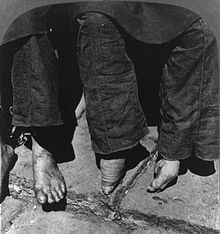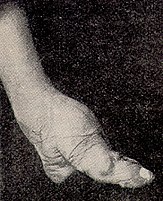Reflecting on China gives me hope that one day FGM *will* be a thing of the past [View all]
Foot binding (also known as "Lotus feet"

is the custom of applying painfully tight binding to the feet of young girls to prevent further growth. The practice possibly originated among upper-class court dancers during the Five Dynasties and Ten Kingdoms period in Imperial China (10th or 11th century), but spread in the Song Dynasty and eventually became common among all but the lowest of classes. Foot binding became popular as a means of displaying status (women from wealthy families who did not need them to work could afford to have their feet bound) and was correspondingly adopted as a symbol of beauty in Chinese culture.
The Manchu Emperor Kangxi tried to ban footbinding in 1664 but failed.[1] In the 1800s (19th century), Chinese reformers challenged the practice but it was not until the early 20th century that foot binding began to die out, partly from changing social conditions and partly as a result of anti-foot binding campaigns.[2] Foot-binding resulted in lifelong disabilities for most of its subjects, and some elderly Chinese women still survive today with disabilities related to their bound feet.[3]
Demise
In 1874, 60 Christian women in Xiamen called for an end of the practice and it was championed by the Woman's Christian Temperance Movement in 1883, and advocated by missionaries including Timothy Richard, who thought that Christianity could promote equality between the sexes.[14] Educated Chinese began to realise that this aspect of their culture did not reflect well upon the progress of the modern rising world; Social Darwinists argued that it weakened the nation, since enfeebled women supposedly produced weak sons; and feminists attacked the practice because it caused women to suffer.[15] At the turn of the 20th century, well-born women such as Kwan Siew-Wah (known in the West as Brigitte Kwan), a pioneering feminist, advocated for the end of foot-binding. The Empress Dowager Cixi issued an anti-foot binding edict in 1902, at first to little effect.[16]
Foot binding continued to be widely practiced until the 1930s.[17]
An X-ray of two bound feet

A woman with her feet unwrapped

A comparison between a woman with normal feet (left) and a woman with bound feet in 1902

A bound foot

more at link:
http://en.wikipedia.org/wiki/Foot_binding



